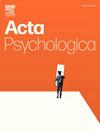经颅交流电刺激(tACS)和认知偏倚矫正(CBM)治疗阿片类药物依赖患者焦虑、抑郁、注意偏倚和药物渴求的有效性
IF 2.1
4区 心理学
Q2 PSYCHOLOGY, EXPERIMENTAL
引用次数: 0
摘要
物质使用障碍(SUDs)在全球范围内构成重大挑战,阿片类药物成瘾尤其普遍。本研究探讨了10hz和个体α频率(IAF)的经颅交流电刺激(tACS)以及认知偏差修正(CBM)对sud患者药物渴望、焦虑、抑郁和注意偏差的影响。方法将72例受试者分为对照组、tACS 10 Hz组、tACS IAF组、Sham组、CBM组和CBM + tACS组,每组12例。测量方法包括人口统计问卷、点探测任务、药物欲望问卷(DDQ)、DASS-21评估和视觉模拟量表(VAS)。进行了混合重复测量方差分析,揭示了显著的相互作用(TIME*GROUP),表明不同时间的治疗效果不同。研究结果这项研究涉及72名药物滥用者,他们被分为六组:对照组、tac组和10组Hz, tACS Real, Sham, CBM, CBM + tACS。各组间的人口统计变量相似。混合方差分析显示,所有评估均存在显著的TIME*GROUP交互作用。在焦虑、药物依赖和视觉模拟量表测量中发现显著差异。总之,虽然单独使用tACS和CBM不会导致物质相关问题的显著减少,但将它们联合使用显示出潜力。这项研究强调了大脑如何适应电刺激,并强调了深入研究治疗sud的重要性。然而,有限的参与者可用性和对言语渴望诱导的依赖等局限性表明,在未来的调查中需要更全面的研究设计和多样化的评估方法。本文章由计算机程序翻译,如有差异,请以英文原文为准。
Effectiveness of transcranial alternating current stimulation (tACS) and cognitive bias modification (CBM) in treating anxiety, depression, attentional bias, and drug craving in opioid-dependent patients
Introduction
Substance Use Disorders (SUDs) pose significant challenges globally, with opiate addiction being particularly prevalent. This study investigates the impact of transcranial alternating current stimulation (tACS) at 10 Hz and individual alpha frequencies (IAF), along with cognitive bias modification (CBM), on drug craving, anxiety, depression, and attention bias in individuals with SUDs.
Methods
Participants (N = 72) were allocated to control, tACS 10 Hz, tACS IAF, Sham, CBM, and CBM + tACS groups (n = 12 each). Measures included demographic questionnaires, dot probe tasks, Desires for Drug Questionnaires (DDQ), DASS-21 assessments, and Visual Analog Scale (VAS) for craving. Mixed repeated measures ANOVA were conducted, revealing significant interactions (TIME*GROUP), indicating differential treatment effects over time.
Findings
The study involved 72 substance abusers divided into six groups: control, tACS.10 Hz, tACS Real, Sham, CBM, and CBM + tACS. Demographic variables were similar among groups. Mixed ANOVA showed significant TIME*GROUP interactions for all assessments. Significant differences were found in anxiety, drug dependence, and visual analog scale measures.
Conclusion
In brief, although using tACS and CBM separately didn't lead to significant decreases in substance-related issues, employing them together demonstrated potential. This research underscores how the brain can adapt to electrical stimulation and emphasizes the importance of delving deeper into treating SUDs. However, limitations such as limited participant availability and the reliance on verbal craving induction indicate the necessity for more comprehensive study designs and varied assessment methods in future investigations.
求助全文
通过发布文献求助,成功后即可免费获取论文全文。
去求助
来源期刊

Acta Psychologica
PSYCHOLOGY, EXPERIMENTAL-
CiteScore
3.00
自引率
5.60%
发文量
274
审稿时长
36 weeks
期刊介绍:
Acta Psychologica publishes original articles and extended reviews on selected books in any area of experimental psychology. The focus of the Journal is on empirical studies and evaluative review articles that increase the theoretical understanding of human capabilities.
 求助内容:
求助内容: 应助结果提醒方式:
应助结果提醒方式:


